Triangulum constellation is located in the northern sky. Its name means “the triangle” in Latin.
Triangulum is one of the Greek constellations. It was first catalogued by the Greek astronomer Ptolemy in the 2nd century. It does not have any first magnitude stars. The three brightest stars in the constellation form the shape of a long, narrow triangle.
The constellation is home to the Triangulum Galaxy (Messier 33), one of the nearest and best known galaxies in the night sky.
Facts, location and map
Triangulum is the 78th constellation in size, occupying an area of 132 square degrees. It lies in the first quadrant of the northern hemisphere (NQ1) and can be seen at latitudes between +90° and -60°. The neighboring constellations are Andromeda, Aries, Perseus and Pisces.
The constellation name Triangulum is pronounced /traɪˈæŋɡjʊləm/. In English, the constellation is known as the Triangle. The genitive form of Triangulum, used in star names, is Trianguli (pronunciation: /traɪˈæŋɡjʊlaɪ/). The three-letter abbreviation, adopted by the International Astronomical Union (IAU) in 1922, is Tri.
Triangulum belongs to the Perseus family of constellations, along with Andromeda, Auriga, Cassiopeia, Cepheus, Cetus, Lacerta, Pegasus and Perseus.
Triangulum has one star with a confirmed planet and contains one Messier object, Messier 33 (M33, NGC 598, Triangulum Galaxy). The brightest star in the constellation is Beta Trianguli, with an apparent magnitude of 3.00. There are no meteor showers associated with the constellation.
Triangulum contains two named stars. The names of stars that have been officially approved by the International Astronomical Union (IAU) are Horna and Mothallah.
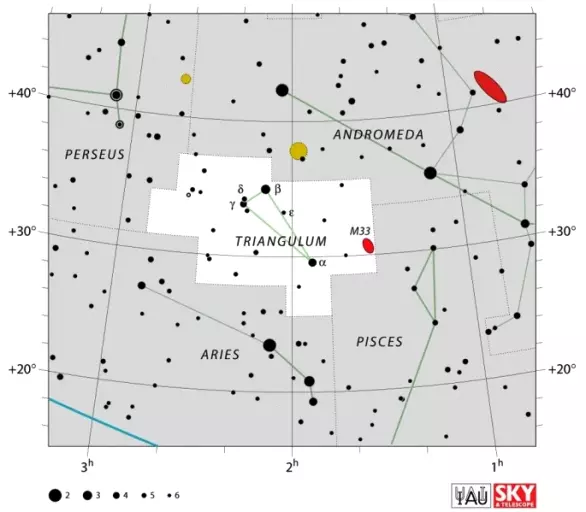
Triangulum constellation map by IAU and Sky&Telescope magazine
Myth
The Greeks knew the constellation as Deltoton, named for its shape, which resembled the capital Greek letter delta. Eratosthenes said that the constellation represented the delta of the river Nile, and Hyginus wrote that some people saw it as the island of Sicily.
Sicilia was one of the early names for the constellation because Ceres, who was the patron goddess of the island, was said to have begged Jupiter to place the island in the sky.
The Babylonians saw Triangulum and the star Gamma Andromedae in Andromeda constellation as a constellation called MUL.Apin, or the Plough.
The Polish astronomer Johannes Hevelius introduced a smaller triangle, Triangulum Minus, in 1687, formed by three stars located near Triangulum, but the division soon fell into disuse.
Triangulum stars
β Trianguli (Beta Trianguli)
Beta Trianguli is the brightest star in Triangulum constellation. It has an apparent magnitude of 3.00 and is approximately 127 light years distant from Earth.
Beta Trianguli is a white giant star with the stellar classification of A5III. It is thought to be a spectroscopic binary star with components separated by less than 5 astronomical units and orbiting each other with a period of 31.39 days.
Beta Trianguli is a source of excess infrared radiation, which suggests that the stars have a ring of dust orbiting them at a distance of 10 to 20 astronomical units.
Mothallah – α Trianguli (Alpha Trianguli)
Alpha Trianguli is the second brightest star in Triangulum. It has an apparent magnitude of 3.42 and is 63.3 light years distant from Earth. It is a very close binary star system, one in which individual stars cannot be resolved. The stars complete an orbit around their centre of mass every 1.736 days. The system is believed to be about 1.6 billion years old.
The primary component in the system is either a subgiant or giant star and the combined stellar classification for the system ranges from F5III to F6IV. The primary star is a rapid rotator and, as a result, it has the shape of an oblate spheroid. When observed from Earth, the star’s ellipsoidal profile varies over the course of an orbit, which in turn causes variations in the star’s luminosity. The star is classified as an ellipsoidal variable.
The traditional name of Alpha Trianguli, Mothallah or Ras al Muthallah, comes from the Arabic ra’s al-muθallaθ, which means “the head of the triangle.” The star is also sometimes known by its Latin name, Caput Trianguli, which has the same meaning.
γ Trianguli (Gamma Trianguli)
Gamma Trianguli is the third brightest star in the constellation. It has an apparent magnitude of 4.01 and is 112.3 light years distant from Earth. It lies along the same line of sight as Delta Trianguli and 7 Trianguli and forms an optical triple star with them.
Gamma Trianguli is a white main sequence star belonging to the stellar class A1Vnn. It has a mass 2.7 times that of the Sun and almost twice the solar radius. It is about 33 times more luminous than the Sun. The star is believed to be about 300 million years old.
Gamma Trianguli is also a rapid rotator, with a projected rotational velocity of 254 km/s, and, like Alpha Trianguli, it has the shape of an oblate spheroid. It has a debris disk orbiting it and, as a result, it is a source of infrared radiation.
δ Trianguli (Delta Trianguli)
Delta Trianguli is another spectroscopic binary in Triangulum. It has a visual magnitude of 4.865 and is only 35.2 light years distant from Earth.
The system is composed of a yellow dwarf belonging to the stellar class G0V and an orange dwarf with an estimated spectral class ranging from G9V to K4V. The stars orbit their centre of mass with an estimated separation of 0.106 astronomical units. They complete an orbit every 10.02 days.
ι Trianguli (Iota Trianguli)
Iota Trianguli is a quadruple star system in Triangulum. It has an apparent magnitude of 4.49 and is approximately 305 light years distant from Earth. The system has the stellar classification F5V.
Iota Trianguli consists of a fifth magnitude G5 giant and a magnitude 6.44 F5 dwarf, separated by 3.8 arc seconds. 6 Triangulum A, the class G giant, is itself a binary star with a class F5 dwarf companion orbiting it every 14.732 days. The giant and the dwarf are 65 and 32 times more luminous than the Sun respectively.
Iota Trianguli B, the other pair, is believed to consist of a pair of class F stars with an orbital period of 2.24 days and luminosities of 18 and 9 times solar. The stars are separated by only 0.05 astronomical units.
Iota Trianguli has the variable designation TZ Trianguli and is classified as an RS Canum Venaticorum type variable, which is to say a close binary star with an active chromosphere that causes large stellar spots, which in turn cause variations in luminosity.
Iota Trianguli used to be the main star in a modern subdivision of ancient Triangulum, which was known as Triangulum Minoris, or “the smaller triangle.” Triangulum Minoris was created in the 1600s and was formed by the stars 6, 10 and 12 Trianguli.
ε Trianguli (Epsilon Trianguli)
Epsilon Trianguli is a binary star system with an apparent magnitude of 5.50. It is approximately 390 light years distant from Earth.
The primary component in the system is a white dwarf belonging to the spectral class A5 V, believed to be about 600 million years old. The star has a radius three times solar. The secondary star has a visual magnitude of 11.4 and lies at a separation of 3.9 seconds of arc from the primary star. The primary component is believed to have a dusty disk in orbit because it emits excess infrared radiation.
Epsilon Trianguli is a suspected member of the Ursa Major Moving Group of stars that share a common motion through space.
HD 13189
HD 13189 is an evolved orange giant with the stellar classification K1II-III. It has an apparent magnitude of 7.57 and is approximately 1,800 light years distant from Earth. It has 2-7 times the Sun’s mass and is about 3,980 times more luminous than the Sun.
In 2005, a brown dwarf or planetary companion was discovered orbiting the star. The companion, HD 13189 b, has a mass 8 to 20 times that of Jupiter and completes an orbit around the star every 472 days from a separation of 1.85 astronomical units.
HD 9446
HD 9446 is a yellow main sequence dwarf with an apparent magnitude of 8.35. The star is approximately 171 light years distant from Earth. It has the same mass and radius as the Sun and roughly the same luminosity.
Two planets were discovered in the star’s orbit in January 2010. HD 9446 b has a mass 0.7 times that of Jupiter and orbits the star every 30.052 days, and HD 9446 c has 1.82 Jupiter masses and completes an orbit around the star every 192.9 days.
Deep sky objects in Triangulum
Triangulum Galaxy – Messier 33 (M33, NGC 598)
The Triangulum Galaxy is a spiral galaxy in Triangulum. It is one of the most distant deep sky objects that can be seen without binoculars. The galaxy has an apparent magnitude of 5.72 and is between 2,380 and 3,070 thousand light years distant from Earth.
Messier 33 is the third largest member of the Local Group of galaxies, after the Milky Way and Andromeda Galaxy. It is about 50,000 light years in diameter and contains about 40 billion stars. (For comparison, the Milky Way has about 400 billion and Andromeda about a trillion stars.) The galaxy is also home to at least 54 globular clusters.
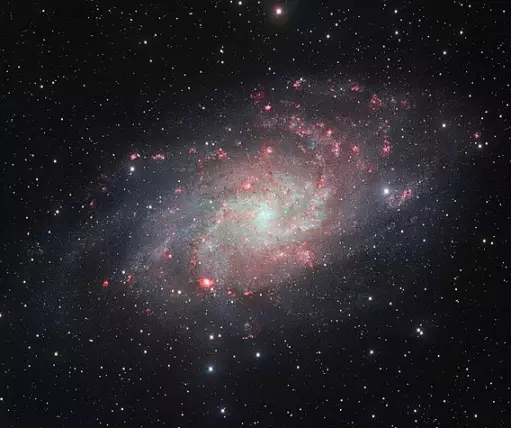
The VLT Survey Telescope (VST) at ESO’s Paranal Observatory in Chile has captured this beautifully detailed image of the galaxy Messier 33, often called the Triangulum Galaxy. This nearby spiral, the second closest large galaxy to our own galaxy, the Milky Way, is packed with bright star clusters, and clouds of gas and dust. This picture is amongst the most detailed wide-field views of this object ever taken and shows the many glowing red gas clouds in the spiral arms with particular clarity. Image: ESO
The Triangulum Galaxy contains the largest stellar mass black hole (a black hole formed by the gravitational collapse of a massive star) known.
The black hole, M33 X-7, was discovered in 2007 and has about 15.7 times the mass of the Sun. It orbits a companion star and eclipses it every 3.45 days. The total mass of the binary system is about 85.7 times that of the Sun. The companion star has a mass about 70 times solar, which makes it the most massive companion star known in a binary system containing a black hole.
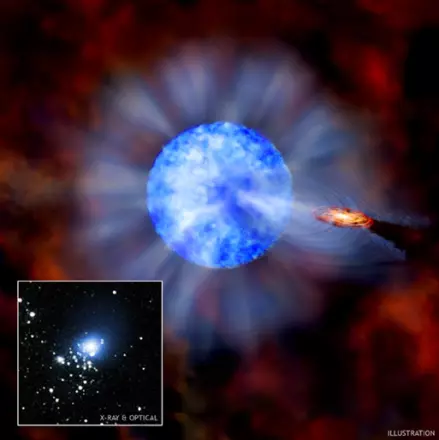
The main component of this graphic is an artist’s representation of M33 X-7, a binary system in the nearby galaxy M33. In this system, a star about 70 times more massive than the Sun (large blue object) is revolving around a black hole. This black hole is almost 16 times the Sun’s mass, a record for black holes created from the collapse of a giant star. Other black holes at the centers of galaxies are much more massive, but this object is the record-setter for a so-called “stellar mass” black hole. In the illustration, an orange disk surrounds the black hole. This depicts material, fed by a wind from the blue companion star, which has been swept into orbit around the black hole. Rather than flowing unimpeded and uniformly into space, wind from the star is pulled towards the black hole by its powerful gravity. The wind that does make it past the black hole is disrupted, causing turbulence and ripples beyond the disk. The companion star itself is also distorted by the gravity from the black hole. The star is stretched slightly in the direction of the black hole, causing it to become less dense in this region and to appear darker. The inset shows a composite of data from NASA’s Chandra X-ray Observatory (blue) and the Hubble Space Telescope. The bright objects in the inset image are young, massive stars around M33 X-7, and the bright, blue Chandra source is M33 X-7 itself. X-rays from Chandra reveals how long the black hole is eclipsed by the companion star, which indicates the size of the companion. Observations by the Gemini telescope on Mauna Kea, Hawaii track the orbital motion of the companion around the black hole, giving information about the mass of the two members of the binary. Other observed properties of the binary were also used to help constrain the mass estimates of both the black hole and its companion. Illustration: NASA, CXC, M.Weiss; X-ray: NASA, CXC, CfA, P.Plucinsky et al.; Optical: NASA, STScI, SDSU, J.Orosz et al.
An arc of hydrogen gas linking Triangulum to the Andromeda Galaxy was discovered in 2004 and confirmed in 2011. This suggests that the two galaxies have tidally interacted in the past.
The Pisces Dwarf, another galaxy in the Local Group, is located 913,000 light years from both galaxies and could be a satellite galaxy of either Triangulum or Andromeda Galaxy.
The Triangulum Galaxy is sometimes also referred to as the Pinwheel Galaxy, but this name is formally used for Messier 101 in Ursa Major constellation.
The Triangulum Galaxy was probably first discovered by the Italian astronomer Giovanni Batista Hodierna before 1654.
Hodierna listed the galaxy as a cloud-like nebulosity in his work De systemate orbis cometici; deque admirandis coeli caracteribus (“About the systematics of the cometary orbit, and about the admirable objects of the sky”).
Charles Messier independently discovered the galaxy on the night of August 25-26, 1764 and included it in his catalogue as object number 33.
William Herschel included the object in his own catalogue of nebulae, and also documented the galaxy’s largest and brightest H II region as H III. 150.
The H II region, a diffuse emission nebula that contains ionized hydrogen, was later designated NGC 604. It is one of the four brightest H II regions in the Triangulum Galaxy, along with NGC 588, NGC 592 and NGC 595.
NGC 604
NGC 604 is an emission nebula located to the northeast of the central core of the Triangulum Galaxy. It is about 1,500 light years in diameter, which makes it one of the largest H II regions known and the brightest H II region in the Triangulum Galaxy. It is also the second most luminous H II region in the Local Group of galaxies.
NGC 604 is more than 6,300 times more luminous than the more famous Orion Nebula in Orion constellation. The gas inside the nebula is ionized by a cluster of massive stars at its centre.
The region was discovered by William Herschel on September 11, 1784. It has an apparent magnitude of 14.
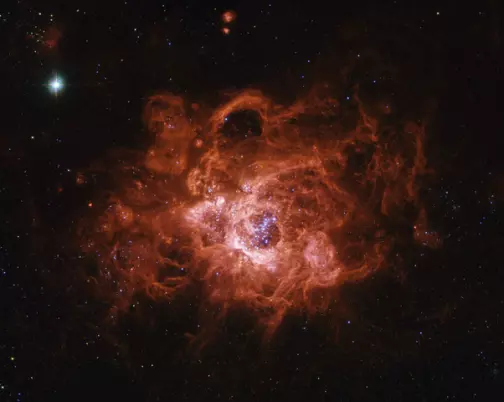
NGC 604, image: Judy Schmidt (CC BY 2.0)
NGC 595
NGC 595 is another H II region in the Triangulum Galaxy, about 3 million light years distant from Earth. It was discovered by the German astronomer Heinrich Ludwig d’Arrest on October 1, 1864.
NGC 634
NGC 634 is a spiral galaxy in Triangulum. It has an apparent magnitude of 14 and is approximately 250 million light years distant from Earth.
The galaxy was discovered by the French astronomer Édouard Stephan in the 19th century. In 2008, a Type Ia supernova, SN 2008a, was observed in the galaxy.
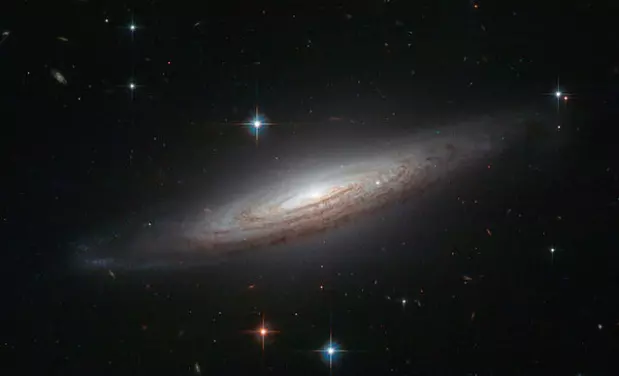
NGC 634 – This spiral galaxy was discovered back in the nineteenth century by French astronomer Édouard Jean-Marie Stephan, but in 2008 it became a prime target for observations thanks to the dramatic demise of a white dwarf star. The type Ia supernova known as SN2008a was spotted in the galaxy and briefly rivalled the brilliance of its entire host galaxy but, despite the energy of the event, it can no longer be seen this Hubble image, which was taken around a year and a half later. Image: ESA, Hubble, NASA
NGC 925
NGC 925 is a barred spiral galaxy in Triangulum. It has a visual magnitude of 10.7 and is approximately 45 million light years distant from Earth.
NGC 672 and IC 1727
NGC 672 and IC 1727 are a pair of interacting galaxies in Triangulum. The galaxies are only 88,000 light years distant from each other, and about 18 million light years distant from Earth. They are located outside the Local Group of galaxies.
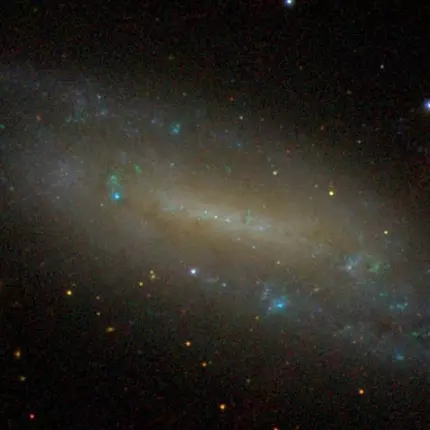
NGC 672, image: Sloan Digital Sky Survey
NGC 672 is a barred spiral galaxy with an apparent magnitude of 10.7 and IC 1727 has a visual magnitude of 11.4. NGC 672 was discovered by William Herschel on October 26, 1786, and IC 1727 was first spotted by Isaac Roberts on October 29, 1896.
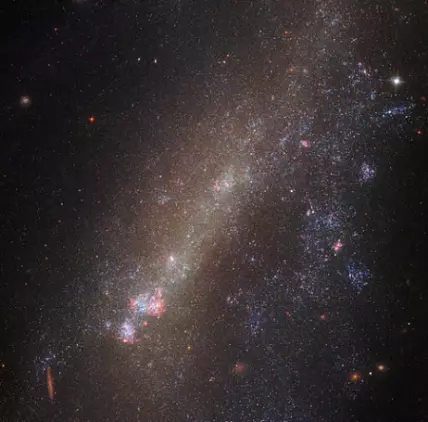
Gravity governs the movements of the cosmos. It draws flocks of galaxies together to form small groups and more massive galaxy clusters, and brings duos so close that they begin to tug at one another. This latter scenario can have dramatic consequences, with members of interacting pairs of galaxies often being highly distorted, torn apart, or driven to smash into one another, abandoning their former identities and merging to form a single accumulation of gas, dust, and stars. The subject of this NASA/ESA Hubble Space Telescope image, IC 1727, is currently interacting with its near neighbour, NGC 672 (which is just out of frame). The pair’s interactions have triggered peculiar and intriguing phenomena within both objects — most noticeably in IC 1727. The galaxy’s structure is visibly twisted and asymmetric, and its bright nucleus has been dragged off-centre. In interacting galaxies such as these, astronomers often see signs of intense star formation (in episodic flurries known as starbursts) and spot newly-formed star clusters. They are thought to be caused by gravity churning, redistributing, and compacting the gas and dust. In fact, astronomers have analysed the star formation within IC 1727 and NGC 672 and discovered something interesting — observations show that simultaneous bursts of star formation occurred in both galaxies some 20 to 30 and 450 to 750 million years ago. The most likely explanation for this is that the galaxies are indeed an interacting pair, approaching each other every so often and swirling up gas and dust as they pass close by. Image: ESA/Hubble & NASA
NGC 784
NGC 784 is another barred spiral galaxy. It lies within the Virgo Supercluster. The galaxy has an apparent magnitude of 12.23 and is approximately 16 million light years distant from the Sun.
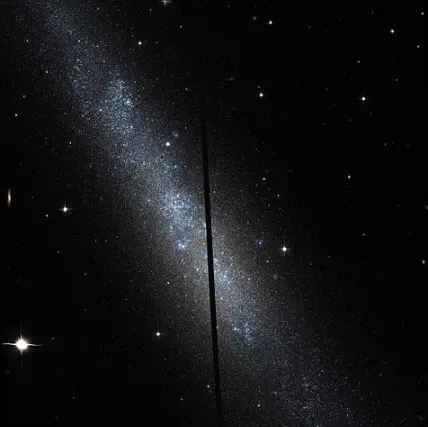
NGC 784, image: NASA
NGC 953
NGC 953 is an elliptical galaxy in Triangulum. It has an apparent magnitude of 14.5. It was discovered by the German astronomer Heinrich Louis d’Arrest on September 26, 1865.